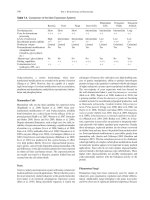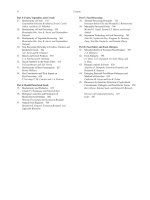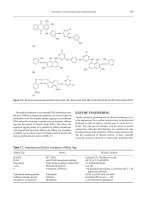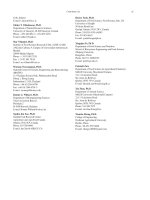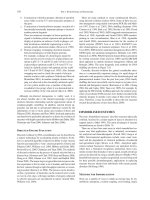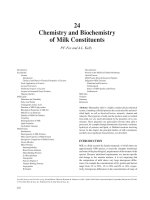8 food biochemistry and food phần 31
Bạn đang xem bản rút gọn của tài liệu. Xem và tải ngay bản đầy đủ của tài liệu tại đây (499.89 KB, 5 trang )
P1: SFK/UKS
BLBS102-c07
P2: SFK
BLBS102-Simpson
March 21, 2012
11:12
Trim: 276mm X 219mm
140
Printer Name: Yet to Come
Part 2: Biotechnology and Enzymology
Table 7.4. Comparison of the Main Expression Systems
Bacteria
Developing time
Costs for downstream
processing
Levels of expression
Recombinant protein stability
Production volume
Postranslational modifications
(disulphide bond
formation, glycosylation,
etc.)
‘Human-type’ glycosylation
Folding capabilities
Contamination level
(pathogens, EPL, etc.)
Yeast
Fungi
Insect Cells
Mammalian
Cells
Transgenic
Plants
Transgenic
Animals
Short
+++
Short
++
Short
++
Intermediate
++
Intermediate
++
Intermediate
++
Long
++
High
+/−
Limited
No
Intermediate
+/−
Limited
Yes
Intermediate
+/−
Limited
Yes
Intermediate
+/−
Limited
Yes
Low
+/−
Limited
Yes
Low
+++
Unlimited
Yes
Low
+/−
Unlimited
Yes
No
−
++
No
++
−
No
+++
−
No
+++
−
Yes
+++
++
No
+++
−
Yes
+++
++
O-glycosylation), a serious disadvantage, when posttranslational modifications are essential to the protein’s function
(Zhang et al. 2004). However, they are capable of a surprisingly broad range of covalent modifications such as acetylation,
amidation and deamidation, methylation, myristylation, biotinylation and phosphorylation.
Mammalian Cells
Mammalian cells are the ideal candidate for expression hosts
(Engelhardt et al. 2009, Hacker et al. 2009) when posttranslational modifications (N- and O-glycosylation, disulfide
bond formation) are a critical factor for the efficacy of the expressed protein (Baldi et al. 2007, Werner et al. 2007, Durocher
and Butler 2009, Geisse and Fux 2009, Hacker et al. 2009).
Despite substantial limitations, such as high cost, low yield, instability of expression and time-consuming, a significant number
of proteins (e.g. cytokines; Fox et al. 2004, Sunley et al. 2008,
Suen et al. 2010), antibodies (Kim et al. 2008, Chusainow et al.
2009), enzymes (Zhuge et al. 2004), viral antigens (Holzer et al.
2003), blood factors and related proteins (Halabian et al. 2009,
Su et al. 2010) are produced in this system because it offers
very high product fidelity. However, oligosaccharide processing is species- and cell type-dependent among mammalian cells
and differences in the glycosylation pattern have been reported
in rodent cell lines and human tissues. The expressed proteins
are usually recovered in a bioactive, properly folded form and
secreted into the cell culture fluids.
advantages of bacteria (low cultivation cost, high doubling rate,
ease of genetic manipulation, ability to produce heterologous
proteins in large-scale quantities) combined with the advantages
of higher eukaryotic systems (post-translational modifications).
The vast majority of yeast expression work has focused on
the well-characterised baker’s yeast Saccharomyces cerevisiae
(Holz et al. 2003, Terpitz et al. 2008, Joubert et al. 2010), but
a growing number of non-Saccharomyces yeasts are becoming
available as hosts for recombinant polypeptide production, such
as Hansenula polymorpha, Candida boidinii, Kluyveromyces
lactis, Pichia pastoris (Cregg et al. 2000, Jahic et al. 2006, van
Ooyen et al. 2006, Yurimoto and Sakai 2009), Schizosaccharomyces pombe (Alberti et al. 2007, Ahn et al. 2009, Takegawa
et al. 2009), Schwanniomyces occidentalis and Yarrowia lipolytica (Madzak et al. 2004, 2005, Bankar et al. 2009). As in bacteria, expression in yeast relies on episomal or integrated multicopy plasmids with tightly regulated gene expression. Despite
these advantages, expressed proteins are not always recovered
in soluble form and may have to be purified from inclusion bodies. Post-translational modifications in yeast differ greatly from
mammalian cells (Jacobs and Callewaert 2009, Hamilton and
Gerngross 2007). This has sometimes proven to be a hindrance
when high fidelity of complex carbohydrate modifications found
in eukaryotic proteins appears to be important in many medical
applications. Yeast cells do not add complex oligosaccharides
and are limited to the high-mannose-type carbohydrates. These
higher order oligosaccharides are possibly immunogenic and
could potentially interfere with the biological activity of the
protein.
Yeast
Yeast is a widely used expression system with many commercial,
medical and basic research applications. The fact that the yeast is
the most intensively studied eukaryote at the genetic/molecular
level makes it an extremely advantageous expression system
(Idiris et al. 2010). Being unicellular organism, it retains the
Filamentous Fungi
Filamentous fungi have been extensively used for studies of
eukaryotic gene organisation, regulation and cellular differentiation. Additionally, fungi belonging to the genus Aspergillus
and Penicillium are of significant industrial importance because
P1: SFK/UKS
BLBS102-c07
P2: SFK
BLBS102-Simpson
March 21, 2012
11:12
Trim: 276mm X 219mm
Printer Name: Yet to Come
7 Biocatalysis, Enzyme Engineering and Biotechnology
of their applications in food fermentation and their ability to
secrete a broad range of biopolymer degrading enzymes and to
produce primary (organic acids) and secondary metabolites (antibiotics, vitamins). The extensive genetic knowledge as well as
the already well-developed fermentation technology has allowed
for the development of heterologous protein expression systems
(Nevalainen et al. 2005, Wang et al. 2005) expressing fungal
(e.g. glucoamylase (Verdoes et al. 1993), propyl aminopeptidase (Matsushita-Morita et al. 2009)) or mammalian (e.g. human interleukin-6 (Contreras et al. 1991), antitrypsin (Chill et al.
2009), lactoferrin (Ward et al. 1995), bovine chymosin (Ward
et al. 1990, Cardoza et al. 2003)) proteins of industrial and clinical interest using filamentous fungi as hosts. However, the expression levels of mammalian proteins expressed in Aspergillus
and Trichoderma species are low compared to homologous proteins. Significant advances in heterologous protein expression
have dramatically improved the expression efficiency by fusing the heterologous gene to the 3 -end of a highly expressed
homologous gene (mainly glucoamylase). Even so, limitations
in protein folding, post-translational modifications, translocation and secretion as well as secretion of extracellular proteases
could pose a significant hindrance for the production of bioactive
proteins (Gouka et al. 1997, Nevalainen et al. 2005, Lubertozzi
and Keasling 2009).
Insect Cells
Recombinant baculoviruses are widely used as a vector for the
expression of recombinant proteins in insect cells (Hitchman
et al. 2009, Jarvis 2009, Trometer and Falson 2010), such as
enzymes (Zhao et al. 2010), immunoglobulins (Iizuka et al.
2009), viral antigens (Takahashi et al. 2010) and transcription
factors (Fabian et al. 1998). The recombinant genes are usually
expressed under the control of the polyhedrin or p10 promoter
of the Autographa californica nuclear polyhedrosis virus (AcNPV) in cultured insect cells of Spodoptera frugiperda (Sf9
cells) or in insect larvae of Lepidopteran species infected with
the recombinant baculovirus containing the gene of interest. The
polyhedron and p10 genes possess very strong promoters and
are highly transcribed during the late stages of the viral cycle.
Usually, the recombinant proteins are recovered from the infected insect cells in soluble form and targeted in the proper
cellular environment (membrane, nucleus and cytoplasm). Insect cells have many post-translational modification, transport
and processing mechanisms found in higher eukaryotic cells
(Durocher and Butler 2009), although their glycosylation efficiency is limited and they are not able to process complex-type
oligosaccharides containing fucose, galactose and sialic acid.
Dictyostelium discoideum
Recently, the cellular slime mould Dictyostelium discoideum, a
well-studied single-celled organism, has emerged as a promising eukaryotic alternative system (Arya et al. 2008b) for the
expression of recombinant proteins (e.g. human antithrombin
III; Dingermann et al. 1991, Tiltscher and Storr 1993, Dittrich
et al. 1994) and enzymes (e.g. phosphodiesterase; Arya et al.
141
2008a). Its advantage over other expression systems lies in its
extensive post-translational modification system (glycosylation,
phosphorylation, acylation), which resembles that of higher eukaryotes (Jung and Williams 1997, Jung et al. 1997, Slade et al.
1997). It is a simple organism with a haploid genome of 5 ×
107 bp and a life cycle that alternates between single-celled and
multicellular stages. Recombinant proteins are expressed from
extrachromosomal plasmids (Dictyostelium discoideum is one
of a few eukaryotes that have circular nuclear plasmids) rather
than being integrated in the genome (Ahern et al. 1988). The nuclear plasmids can be easily genetically manipulated and isolated
in a one-step procedure, as in bacteria. This system is ideally
suited for the expression of complex glycoproteins and although
it retains many of the advantages of the bacterial (low cultivation
cost) and mammalian systems (establishment of stable cell lines,
glycosylation), the development of this system at an industrial
scale is hampered by the relatively low productivity, compared
to bacterial systems.
Trypanosomatid Protozoa
A newly developed eukaryotic expression system is based on the
protozoan lizard parasites of the Leishmania and Trypanosoma
species (Basile and Peticca 2009). Its gene and protein regulation and editing mechanisms are remarkably similar to those of
higher eukaryotes and include the capability of ‘mammalianlike’ glycosylation. It has a very rapid doubling time and can be
grown to high densities in relatively inexpensive medium. The
recombinant gene is integrated into the small ribosomal subunit
rRNA gene and can be expressed to high levels. Increased expression levels and additional promoter control can be achieved
in T7 polymerase-expressing strains. Being a lizard parasite, it is
not pathogenic to humans, which makes this system invaluable
and highly versatile. Proteins and enzymes of significant interest, such as human tissue plasminogen activator (Soleimani et al.
2007), EPO (Breitling et al. 2002), IFNγ (Tobin et al. 1993) and
IL-2 (La Flamme 1995), have been successfully expressed in
this system.
Transgenic Plants
The current protein therapeutics market is clearly an area of
enormous interest from a medical and economic point of view.
Recent advances in human genomics and biotechnology have
made it possible to identify a plethora of potentially important drugs or drug targets. Transgenic technology has provided
an alternative, more cost-effective bioproduction system than
the previously used (E. coli, yeast, mammalian cells; Larrick
and Thomas 2001, Demain and Vaishnav 2009). The accumulated knowledge on plant genetic manipulation has been recently applied to the development of plant bioproduction systems (Twyman et al. 2005, Boehm 2007, Lienard et al. 2007,
Faye and Champey 2008, Sourrouille et al. 2009). Expression in
plants could be either constitutive or transient and directed to a
specific tissue of the plant (depending on the type of promoter
used). Expression of heterologous proteins in plants offers significant advantages, such as low production cost, high biomass
P1: SFK/UKS
BLBS102-c07
P2: SFK
BLBS102-Simpson
March 21, 2012
142
11:12
Trim: 276mm X 219mm
Printer Name: Yet to Come
Part 2: Biotechnology and Enzymology
production, unlimited supply and ease of expandability. Plants
also have high-fidelity expression, folding and post-translational
modification mechanisms, which could produce human proteins
of substantial structural and functional equivalency compared
to proteins from mammalian expression systems (Gomord and
Faye 2004, Joshi and Lopez 2005). Additionally, plant-made human proteins of clinical interest (Schillberg et al. 2005, Twyman
et al. 2005, Vitale and Pedrazzini 2005, Tiwari et al. 2009), such
as antibodies (Hassan et al. 2008, Ko et al. 2009, De Muynck
et al. 2010, Lai et al. 2010), vaccines (Hooper 2009, Alvarez
and Cardineau 2010), cytokines (Elias-Lopez et al. 2008) and
enzymes (Kermode et al. 2007, Stein et al. 2009), are free of potentially hazardous human diseases, viruses or bacterial toxins.
However, there is considerable concern regarding the potential
hazards of contamination of the natural gene pool by the transgenes and possible additional safety precautions will raise the
production cost.
Transgenic Animals
Besides plants, transgenic technology has also been applied to
many different species of animals (mice, cows, rabbits, sheep,
goats and pigs; Niemann and Kues 2007, Houdebine 2009).
The DNA containing the gene of interest is microinjected into
the pronucleus of a single-cell fertilised zygote and integrated
into the genome of the recipient; therefore, it can be faithfully
passed on from generation to generation. The gene of interest
is coupled with a signal targeting protein expression towards
specific tissues, mainly the mammary gland, and the protein
can therefore be harvested and purified from milk. The proteins
produced by transgenic animals are almost identical to human
proteins, greatly expanding the applications of transgenic animals in medicine and biotechnology. Several human protein of
pharmaceutical value have been produced in transgenic animals,
such as haemoglobin (Swanson 1992, Logan and Martin 1994),
lactoferrin (Han et al. 2008, Yang et al. 2008), antithrombin III
(Yang et al. 2009), protein C (Velander 1992) and fibrinogen
(Prunkard 1996), and there is enormous interest for the generation of transgenic tissues suitable for transplantation in humans
(only recently overshadowed by primary blastocyte technology
(Klimanskaya et al. 2008)). Despite the initial technological expertise required to produce a transgenic animal, the subsequent
operational costs are low and subsequent inbreeding ensures that
the ability to produce the transgenic protein will be passed on
to its offspring. However, certain safety issues have arisen concerning the potential contamination of transgenically produced
proteins by animal viruses or prions, which could possibly be
passed on to the human population. Extensive testing required
by the FDA substantially raises downstream costs.
Enzyme Purification
Once a suitable enzyme source has been identified, it becomes
necessary to design an appropriate purification procedure to isolate the desired protein. The extent of purification required for
an enzyme depends on several factors, the most important of
which being the degree of enzyme purity required as well as
Table 7.5. Protein Properties Used During Purification
Protein Property
Technique
Solubility
Size
Charge
Hydrophobicity
Biorecognition
Precipitation
Gel filtration
Ion exchange
Hydrophobic interaction chromatography
Affinity chromatography
the starting material, for example the quantity of the desired
enzyme present in the initial preparation (Lesley 2001, Labrou
and Clonis 2002). For example, industrial enzymes are usually
produced as relatively crude preparations. Enzymes used for
therapeutic or diagnostic purposes are generally subjected to the
most stringent purification procedures, as the presence of compounds other than the intended product may have an adverse
clinical impact (Berthold and Walter 1994).
Purification of an enzyme usually occurs by a series of independent steps in which the various physicochemical properties
of the enzyme of interest are utilised to separate it progressively
from other unwanted constituents (Labrou and Clonis 2002,
Labrou et al. 2004b). The characteristics of proteins that are
utilised in purification include solubility, ionic charge, molecular size, adsorption properties and binding affinity to other
biological molecules. Several methods that exploit differences
in these properties are listed in Table 7.5.
Precipitation methods (usually employing (NH4 )2 SO4 ,
polyethyleneglycol or organic solvents) are not very efficient
method of purification (Labrou and Clonis 2002). They typically give only a few fold purification. However, with these
methods, the protein may be removed from the growth medium
or from cell debris where harmful proteases and other detrimental compounds may affect protein stability. On the other
hand, chromatography is a highly selective separation technique (Regnier 1987, Fausnaugh 1990). A wide range of chromatographic techniques has been used for enzyme purification:
size-exclusion chromatography, ion-exchange, hydroxyapatite,
hydrophobic interaction chromatography, reverse-phase chromatography and affinity chromatography (Labrou 2003). Of
these, ion-exchange and affinity chromatography are the most
common and probably the most important (Labrou and Clonis
1994).
Ion-Exchange Chromatography
Ion-exchange resins selectively bind proteins of opposite charge;
that is, a negatively charged resin will bind proteins with a net
positive charge and vice versa (Fig. 7.13). Charged groups are
classified according to type (cationic and anionic) and strength
(strong or weak); the charge characteristics of strong ion exchange media do not change with pH, whereas with weak ionexchange media they do. The most commonly used charged
groups include diethylaminoethyl, a weakly anionic exchanger;
carboxymethyl, a weakly cationic exchanger; quaternary ammonium, a strongly anionic exchanger; and methyl sulfonate,
P1: SFK/UKS
BLBS102-c07
P2: SFK
BLBS102-Simpson
March 21, 2012
11:12
Trim: 276mm X 219mm
Printer Name: Yet to Come
7 Biocatalysis, Enzyme Engineering and Biotechnology
(A)
143
counter-ion displacement; washing of the unbound contaminating proteins, enzymes, nucleic acids and other compounds;
introduction of elution conditions in order to displace bound
proteins; and regeneration and re-equilibration of the adsorbent
for subsequent purifications. Elution may be achieved either by
increasing the salt concentration or by changing the pH of the
irrigating buffer. Both methods are used in industry, but raising the salt concentration is by far the most common because it
is easier to control (Levison 2003). Most protein purifications
are done on anion exchange columns because most proteins are
negatively charged at physiological pH values (pH 6–8).
Affinity Chromatography
(B)
Figure 7.13. (A) Schematic diagram of a chromatogram showing
the steps for a putative purification. (B) Schematic diagram
depicting the principle of ion-exchange chromatography.
a strongly cationic exchanger (Table 7.6; Levison 2003). The
matrix material for the column is usually formed from beads of
carbohydrate polymers, such as agarose, cellulose or dextrans
(Levison 2003).
The technique takes place in five steps (Labrou 2000;
Fig. 7.13): equilibration of the column to pH and ionic strength
conditions suitable for target protein binding; protein sample
application to the column and reversible adsorption through
Affinity chromatography is potentially the most powerful and
selective method for protein purification (Fig. 7.14; Labrou
and Clonis 1994, Labrou 2003). According to the International
Union of Pure and Applied Chemistry, affinity chromatography
is defined as a liquid chromatographic technique that makes use
of a ‘biological interaction’ for the separation and analysis of
specific analytes within a sample. Examples of these interactions
include the binding of an enzyme with a substrate/inhibitor or
of an antibody with an antigen or in general the interaction of
a protein with a binding agent, known as the ‘affinity ligand’
(Fig. 7.14; Labrou 2002, 2003, Labrou et al. 2004b). The development of an affinity chromatography-based purification step
involves the consideration of the following factors: (i) selection
of an appropriate ligand and (ii) immobilisation of the ligand
onto a suitable support matrix to make an affinity adsorbent.
The selection of the immobilised ligand for affinity chromatography is the most challenging aspect of preparing an affinity
adsorbent. Certain factors need to be considered when selecting
a ligand (Labrou and Clonis 1995, 1996): (i) the specificity of
the ligand for the protein of interest, (ii) the reversibility of the
interaction with the protein, (iii) its stability against the biological and chemical operation conditions and (iv) the affinity of
the ligand for the protein of interest. The binding site of a protein is often located deep within the molecule and adsorbents
prepared by coupling the ligands directly to the support exhibit
low binding capacities. This is due to steric interference between
the support matrix and the protein’s binding site. In these circumstances, a ‘spacer arm’ is inserted between the matrix and
ligand to facilitate effective binding (Fig. 7.14). A hexyl spacer
is usually inserted between ligand and support by substitution
of 1,6-diaminohexane (Lowe 2001).
The ideal matrix should be hydrophilic, chemically and biologically stable and have sufficient modifiable groups to permit
an appropriate degree of substitution with the enzyme. Sepharose
is the most commonly used matrix for affinity chromatography
on the research scale. Sepharose is a commercially available
beaded polymer, which is highly hydrophilic and generally inert
to microbiological attack (Labrou and Clonis 2002). Chemically,
it is an agarose (poly-{β-1,3-d-galactose-α-1,4-(3,6-anhydro)l-galactose}) derivative.
The selection of conditions for an optimum affinity chromatographic purification involves the study of the following factors:
(1) choice of adsorption conditions (e.g. buffer composition,
P1: SFK/UKS
BLBS102-c07
P2: SFK
BLBS102-Simpson
March 21, 2012
11:12
Trim: 276mm X 219mm
144
Printer Name: Yet to Come
Part 2: Biotechnology and Enzymology
Table 7.6. Functional Groups Used on Ion Exchangers
Functional Group
Anion exchangers
Diethylaminoethyl (DEAE)
Quaternary aminoethyl (QAE)
Quaternary ammonium (Q)
–O–CH2 –CH2 –N+ H(CH2 CH3 )2
–O–CH2 –CH2 –N+ (C2 H5 )2 –CH2 –CHOH–CH3
–O–CH2 –CHOH–CH2 O–CH2 –CHOH–CH2 N+ (CH3 )2
Cation exchangers
Carboxymethyl (CM)
Sulphopropyl (SP)
–O–CH2 –COO−
–O–CH2 –CHOH–CH2 –O–CH2 –CH2 –CH2 SO3 −
pH, ionic strength) to maximise the conditions required for the
formation of strong complex between the ligand and the protein to be purified, (2) choice of washing conditions to desorb
non-specifically bound proteins and (3) choice of elution conditions to maximise purification (Labrou and Clonis 1995). The
elution conditions of the bound macromolecule should be both
Figure 7.14. Schematic diagram depicting the principle of affinity
chromatography.
tolerated by the affinity adsorbent and effective in desorbing
the biomolecule in good yield and in the native state. Elution
of bound proteins is performed in a non-specific or biospecific
manner. Non-specific elution usually involves (1) changing the
ionic strength (usually by increasing the buffer’s molarity or
including salt, e.g. KCl or NaCl) and the pH (adsorption generally weakens with increasing pH), (2) altering the polarity of
the irrigating buffer by employing, for example ethylene glycol
or other organic solvents, if the hydrophobic contribution in the
protein-ligand complex is large. Biospecific elution is achieved
by inclusion in the equilibration buffer of a suitable ligand, which
usually competes with the immobilised ligand for the same binding site on the enzyme/protein (Labrou 2000). Any competing
ligand may be used. For example, substrates, products, cofactors, inhibitors or allosteric effectors are all potential candidates
as long as they have higher affinity for the macromolecule than
the immobilised ligand.
Dye-ligand affinity chromatography represents a powerful
affinity-based technique for enzyme and protein purification
(Clonis et al. 2000, Labrou 2002, Labrou et al. 2004b). The technique has gained broad popularity due to its simplicity and wide
applicability to purify a variety of proteins. The employed dyes
as affinity ligands are commercial textile chlorotriazine polysulfonated aromatic molecules, which are usually termed as triazine
dyes (Fig. 7.15). Such dye-ligands have found wide applications
over the past 20 years as general affinity ligands in the research
market to purify enzymes, such as oxidoreductases, decarboxylases, glycolytic enzymes, nucleases, hydrolases, lyases, synthetases and transferases (Scopes 1987). Anthraquinone triazine
dyes are probably the most widely used dye-ligands in enzyme
and protein purification. Especially the triazine dye Cibacron
Blue F3GA (Fig. 7.18) has been widely exploited as an affinity
chromatographic tool to separate and purify a variety of proteins (Scopes 1987). With the aim of increasing the specificity
of dye-ligands, the biomimetic dye-ligand concept was introduced. According to this concept, new dyes that mimic natural
ligands of the targeted proteins are designed by substituting the
terminal 2-aminobenzene sulfonate moiety of the dye Cibacron
Blue 3GA (CB3GA) for (η´ with) a substrate-mimetic moiety
(Clonis et al. 2000, Labrou 2002, 2003, Labrou et al. 2004b).
These biomimetic dyes exhibit increased purification ability and
specificity and provide useful tools for designing simple and
effective purification protocols.


